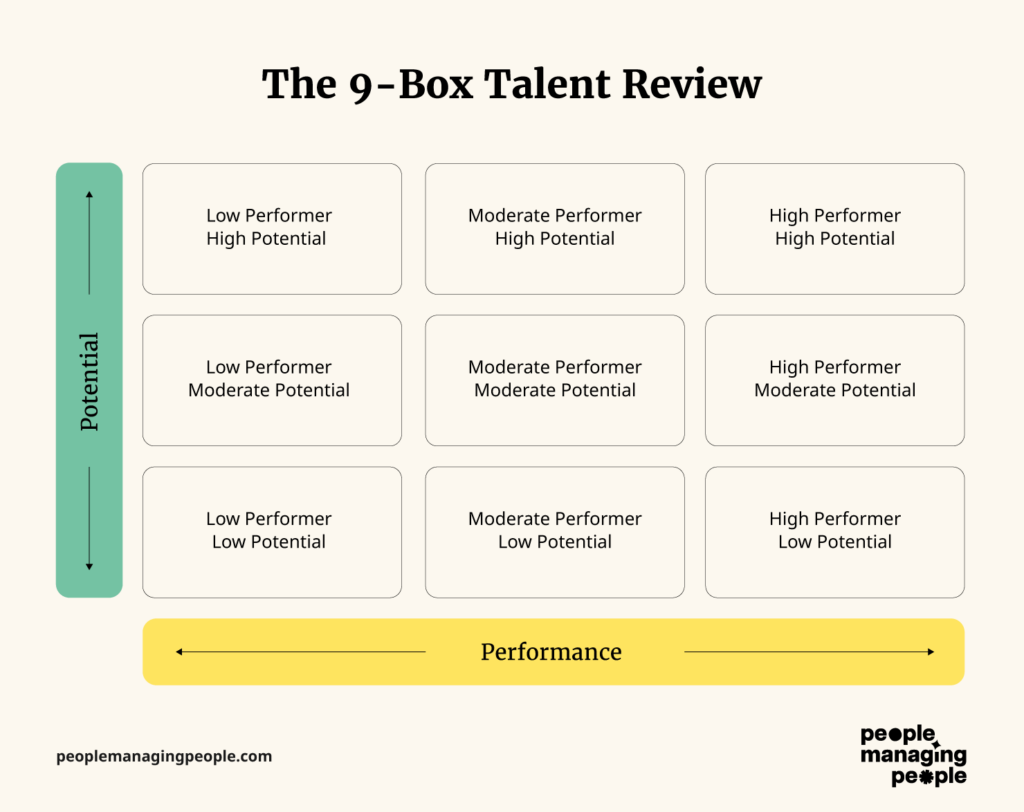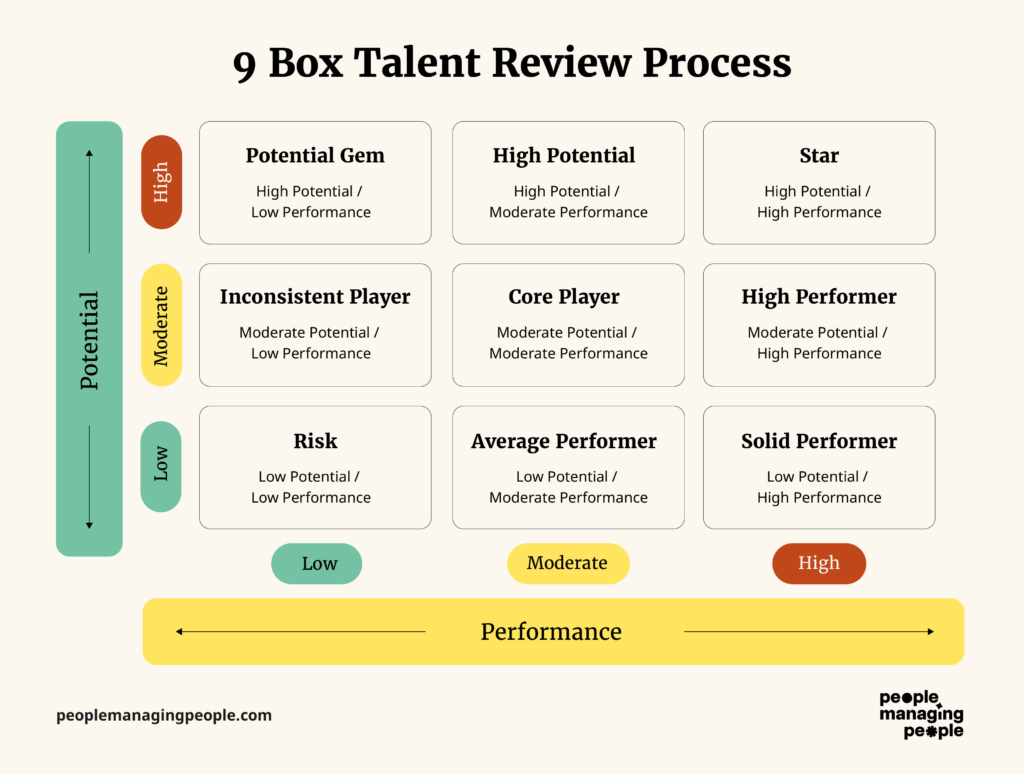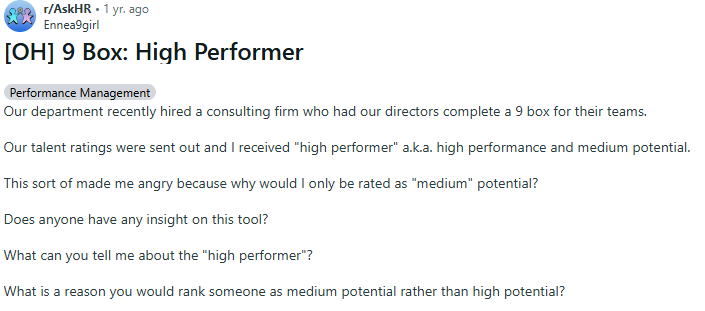Talent Grids Unboxed: Simplicity Meets Strategy: The 9-box talent review is a strategic framework that helps HR evaluate and develop workforce potential and performance, identifying top talent and aiding in succession planning with a straightforward visual grid.
Grid Guide to Future Leaders: This tool's purpose is multifaceted: it identifies potential future leaders, supports employee development plans, and aids in planning seamless leadership transitions by highlighting high-potential talent.
Simplicity is the Spice of Talent Management: Loved by HR for its simplicity, the 9-box review offers a quick visual assessment aiding in talent calibration and informed decisions regarding compensation, succession, and employee development.
On the surface, the 9-box talent review might seem like a bit of a gimmick. But the reality is, it's proven to be a useful tool for HR teams across industries over the years.
In this article, I will guide you through the 9-box talent review process, explain its value, and offer actionable advice for HR professionals looking to make the most of this tool. Whether you're aiming to uncover future leaders or improve talent development strategies, the 9-box talent review can help streamline and optimize your approach.
What is a 9-Box Talent Review?
The 9-box talent review is a strategic framework that helps HR professionals and business leaders evaluate and develop their workforce. It’s a visual tool that uses two axes—performance and potential—to assess employees, making it easier to identify top talent, do a bit of succession planning, and align workforce management with organizational goals.
At its core, the 9-box talent review is a 3x3 grid used to assess employees based on the two key axes I mentioned before:
- Performance: How well an employee is currently performing in their role.
- Potential: An employee’s ability to grow, take on more responsibility, or develop leadership qualities.
This framework places employees in one of nine categories, depending on where they fall in relation to both performance and potential. Depending on the performance management tool you’re using, you may be able to use functionality within the software to mimic this or at the very least, incorporate its data into the process.
Purpose
The 9-box grid serves several important functions in talent management:
- Identifying High Performers and High Potentials: It helps highlight employees who could be the future leaders of your organization.
- Guiding Development Plans: For employees who show promise but need support to grow, the grid helps prioritize targeted development initiatives.
- Supporting Succession Planning: By identifying high-potential employees, HR teams can plan for leadership transitions and build a strong talent pipeline.
“The 9-box talent review is a talent strategy tool used to rate and calibrate employees for decisions around compensation, succession plans, etc,” Heather Doshay, Head of Talent at SignalFire said. “It identifies top talent, steady performers, and those needing development. Its power is in its simplicity. It provides a visual to assess people and make decisions quickly, but also has many shortcomings.”
Why it’s valuable
The 9-box grid is, at least in theory, a data-driven decision-making tool. By plotting employees according to performance and potential, HR leaders can make informed decisions about promotions, career development, and succession planning. This structured approach reduces bias, enhances transparency, and ensures that talent management aligns with the company’s goals.
To provide further insights into the practical benefits of this tool, we spoke with Heather Doshay, an executive expert on talent management. According to Doshay, "The 9-box grid creates a clear, objective framework for discussing talent development, which helps leaders make better decisions and ultimately strengthens organizational performance."
Elements of a 9-Box Talent Review
The 9 box review is loved for its simplicity. Let’s take a look at the primary components that drive the thinking behind it.
Performance axis
The performance axis evaluates an employee’s current job performance, including factors like:
- Achievement of KPIs (Key Performance Indicators)
- Consistency in delivering results
- Quality of work and attention to detail
- Feedback from peers, managers, and clients
For example, a high performer in this axis might be an employee who consistently exceeds their sales targets, provides excellent customer service, and is recognized for their reliability.
Potential axis
The potential axis measures an employee’s ability to grow and take on future responsibilities. This includes factors such as:
- Leadership ability: Does the employee show the potential to lead teams or manage larger projects?
- Adaptability: Can they take on new challenges or adjust to changing business needs?
- Learning agility: Are they quick to pick up new skills and thrive in unfamiliar situations?
For instance, an employee who is proactive in mentoring others or has expressed interest in leadership training may score high on the potential axis.
According to Doshay, reducing a person’s contribution to the business to the two axes involved in the 9 box approach oversimplifies things and requires some adjustments on your part.
“These two simple variables of performance and potential are not optimal inputs as the only two variables to determine such critical decisions from promotion decisions to bonus outcomes,” Doshay wrote in a post for SignalFire’s blog. “Adjusting the axis lines to best align to the use case at hand is critical in ensuring that the tool is working for you and not against you.”
The 9 Categories
The 9-box grid is broken down into nine distinct boxes based on the combination of performance and potential. Here’s a quick breakdown:
- High Performers/High Potentials: These are employees who consistently perform well and have significant growth potential, often seen as future leaders.
- High Performers/Moderate Potentials: These employees are doing well in their current roles but may have less leadership potential. They’re excellent contributors but may require specific development plans to grow.
- Moderate Performers/High Potentials: These employees have room to improve in their current roles but show promise for growth and leadership.
- Moderate Performers/Moderate Potentials: These employees are reliable in their current roles but may need substantial support for further development.
- Low Performers/High Potentials: These employees are underperforming but have the capacity to improve and potentially excel with the right development and support.
- Low Performers/Moderate Potentials: These employees need immediate performance improvement and may have limited potential.
- Low Performers/Low Potentials: These employees may be struggling both in terms of performance and potential, potentially making them candidates for re-evaluation or exit.
- Moderate Performers/Low Potentials: Employees in this category can maintain their current roles but may not be suitable for long-term career growth.
- High Performers/Low Potentials: These employees excel in their current positions but are unlikely to be suitable for future leadership or more advanced roles.
So let’s take a look at this for a moment laid out how it would actually look.

Visualization
Let's say we want to look and see the different sorts of characters within a team and how the organization views their potential moving forward. This may be part of a broader team performance assessment. Think something like this.

The 9-box grid is typically presented as a 3x3 matrix. For clarity, HR professionals can create the grid using tools like Excel templates or HR software.
By plotting employees in this way, you can identify areas for improvement, talent gaps, and future leadership candidates.
Challenges And Solutions
Like any tool, the 9-box grid comes with its challenges. One common issue is bias in evaluations. It’s essential to ensure assessments are based on objective data—such as performance metrics and feedback—rather than subjective impressions.
Another challenge is the overuse of the grid, which can lead to “box fatigue” or a reliance on the grid to solve every HR problem. To avoid this, HR teams should use the 9-box grid in conjunction with other talent management strategies.
What to do with the analysis
Communication is a major barrier to its effectiveness, but not how you might expect. The 9 box is a talent assessment tool that is not meant to be shared with the person being assessed this way. It isn’t strictly a performance management tool, but rather, a talent assessment and succession planning tool.

Reactions like the one you see from a Reddit user above are not uncommon when employees are exposed to the 9 box analysis. Commenters on the thread note that wherever employees are plotted on the grid, it’s best that their manager and leadership teams are the only ones exposed to this information.
A modern approach
The 9 box isn’t anything new and as such, many employees and people who analyze workforce trends are quick to talk about its flaws. For this reason, it’s often not well liked.
Doshay promotes a modernized 9 box review process where leaders can plot performance across three different 9 box formats. They are:
- Performance focused where X axis = Performance; Y axis = Behavior (values alignment)
- Promotions focused where X axis = Individual Readiness; Y axis = Business Need
- Succession focused where X axis = Role Value/Criticality; Y axis= Retention Risk
The performance focused 9 box is fairly similar to the traditional model, while the other two map out the next steps for management. In particular, they focus on goal setting and development. Doshay has seen them used to inform compensation discussions and promotions effectively.
“They provide more value if a company is trying to figure out how to align a pay for performance strategy but also wants to keep cultural behaviors top of mind,” she says. “I’ve seen our modern 9 box used where they swap out potential with "cultural alignment" and were able to align rewards amounts by calibrated box.”
How Does It Work?
The 9-box talent review process involves four main steps that help you effectively assess, place, and analyze your employees' performance and potential. Each step is essential for ensuring that you make data-driven decisions and prioritize the right development strategies for your workforce.
Step 1: Evaluate performance
The first step in the 9-box talent review process is to evaluate the employee’s current performance. Performance appraisals by trained managers help identify how well an employee is executing their role and achieving job-related objectives. Here's how to approach it:
- Define Clear Metrics: Start by establishing specific performance indicators that align with the role's responsibilities and organizational goals. These metrics can include KPIs (Key Performance Indicators), project completion rates, or customer satisfaction scores.
- Gather Feedback: Performance evaluations are not just about numbers. Incorporating feedback from managers, peers, and even subordinates provides a holistic view of an employee’s contribution. 360-degree feedback tools help mitigate biases and provide a more balanced assessment.
- Consider Consistency: Look for sustained performance over time. One-off successes or failures can be misleading. For instance, an employee who consistently meets sales targets over the course of several quarters should be rated more highly than someone who only had a strong performance during one period but struggles to maintain it.
- Use Objective Data: Ensure the use of objective, measurable data such as monthly sales targets, customer feedback, or employee productivity reports. Avoid subjective judgments that can skew the evaluation. Consider incorporating tools like performance reviews, psychometric tests, leadership assessments, behavioral assessments and productivity analytics to support your evaluation.
"A 9-box can give you an indication of your talent depth and breadth, but it’s meaningless without context," Tim Toterhi, CHRO and Coach at Ploterline Leadership said. "The talent review process should begin with an organization/department-level State of The Union, which looks at future needs. You might have great performers for today, but if the industry or market changes, even your best performance may not be good enough for tomorrow’s needs.
"Talent reviews and succession plans are useless without actions that carry the plan forward. If your plans look the same year after year, you failed."
Step 2: Assess potential
The next step is evaluating an employee’s potential—their ability to grow, take on more responsibility, or step into leadership roles in the future. Assessing potential can be more subjective than performance, but there are key methods and indicators to help.
Assess potential by looking at indicators like leadership abilities, learning agility, and adaptability. Tools such as career aspiration surveys, leadership training evaluations, and employee talent assessments can help you assess an employee’s growth potential more accurately.
Ultimately, you’re looking to understand how the person scores in the following areas:
- Adaptability: Look at how employees handle change or navigate new challenges. Do they thrive in uncertain situations? An employee who is quick to adapt to new technologies or processes likely has high potential.
- Leadership Qualities: Evaluate an employee’s leadership qualities by observing how they motivate and support others. This includes their ability to inspire colleagues, delegate tasks, and foster collaboration.
- Learning Agility: Assess an employee's willingness and ability to learn new skills. Employees who demonstrate curiosity, proactivity in learning new technologies, or an eagerness for self-improvement often have high potential.
- Future Readiness: Review career aspirations and alignment with future roles. Use talent assessments and behavioral interviews to uncover growth opportunities and readiness for higher responsibilities.
Involve managers
Managers’ insights into an employee’s ability to take on more responsibility or handle complex projects are some of the most valuable information you have at your disposal. Their input on an employee’s potential for growth and development will guide decisions about how to place them in the grid.
Example: An IT specialist who proactively solves problems, mentors junior colleagues, and expresses interest in leadership training could be deemed as having high potential. Their ability to teach others and innovate makes them a great candidate for future leadership roles.
Step 3: Place employees on the grid
Once performance and potential have been assessed, the next step is to plot employees accurately on the 9-box grid. This requires you to:
- Use a consistent scoring system: Ensure that both performance and potential are rated on a consistent scale across all employees. For instance, you might rate both performance and potential on a 1-5 scale, with 1 being low and 5 being high.
- Be objective and consistent: When placing employees on the grid, be as objective as possible. Keep your ratings consistent with the company’s evaluation standards.
- Document the reasoning: Provide specific examples or evidence that support why an employee was placed in a particular box. If an employee is placed in the "Moderate Performers/High Potential" box, note the specific projects or behaviors that show their growth potential, despite current performance challenges.
- Use HR software or templates: Tools like HR software platforms or even Excel templates can simplify this process by allowing you to track and visualize where employees are placed on the grid. These tools can also help analyze trends and provide insights into organizational strengths and weaknesses.
Step 4: Analyze and interpret results
Once the employees are placed on the grid, it’s time to analyze and interpret the results. This is where you start uncovering trends and determining the strategic actions that need to be taken.
- Identify talent gaps: Look for patterns such as a lack of employees in the "High Potential/High Performer" quadrant. If most of your employees are clustered in the “Low Performers/Low Potential” category, this indicates a need for improved recruitment, training, or performance management processes.
- Address development needs: The analysis should point out employees who need immediate attention. For example, those in the "Low Performers/High Potential" category may require targeted performance improvement plans, while those in the "Moderate Performers/Low Potential" category may benefit from career coaching or reassessment.
- Prioritize resources: Use the grid to allocate resources strategically. High performers with high potential should be fast-tracked for development, whereas low performers may require more intensive training or, in some cases, reconsideration of their fit in the organization.
"I partnered with an HRBP once on to lead a session with a sales team of about 15. Prior to the exercise, managers within the team were rating everyone high on both performance and potential. Once we introduced the tool and had it up on a whiteboard, and as a team talked through and plotted each team member, it became clearer to them how the two differ and how employees differ given the criteria," Catherine Rymsha, author of The Leadership Decision and lecturer on Managerial Leadership at the University of Massachussetts Lowell said.
"The tool, along with plotting as a leadership team and talking through, gives the exercise overall more value. Educating leaders on why this matters and properly segmenting talent is key."
What's Next?
To keep up with all the latest trends in performance management and talent assessment, subscribe to the People Managing People newsletter. You'll get all the latest developments, experts insights and tips straight to your inbox!


